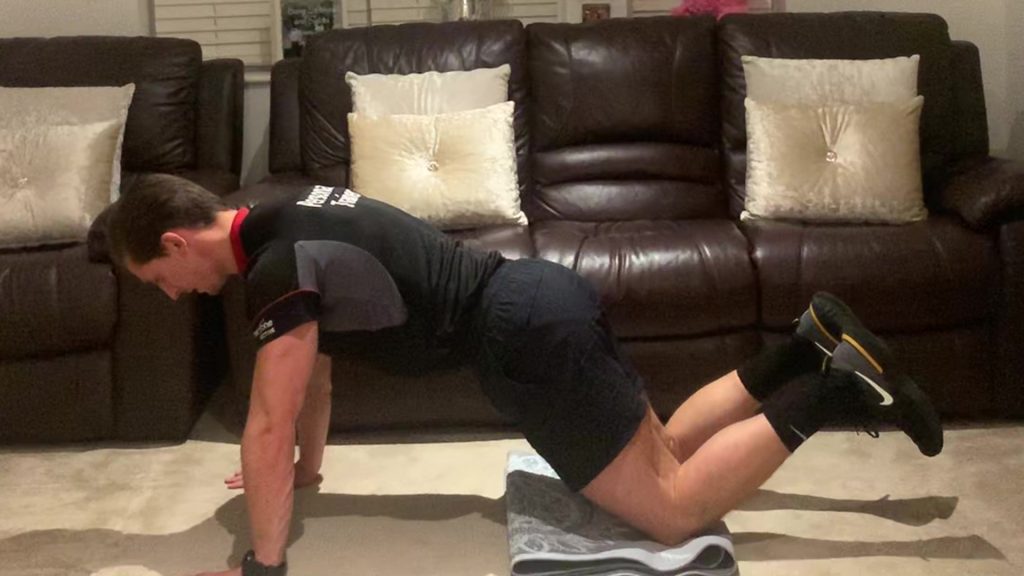Think you know how to do the perfect press-up? Think again. We all probably think we do but it’s a much trickier exercise than we think it is. Luckily, we’ve got Personal Trainer Aaron Dunn to take you through exactly how to execute the perfect press-up. He takes us all the way from beginner’s press-ups on our knees, all the way to more advanced variations on this well-worn theme.
So, warm up, get a bottle of water handy and get ready to really work those triceps, pectorals and your core. Press-ups really are a superb upper-body home workout.
The Perfect Press-up
Executing the perfect press-up takes a fair amount of technique, but as long as you follow these simple steps, you’ll get there. Getting the technique right is important for a number of reasons. Firstly, doing press-ups correctly will mean you get more benefits from doing them. Secondly, you’re also less likely to hurt yourself if you ensure you get the technique right.

Get Your Hands in the Right Place for the Perfect Press-up
Beginning with the standard press-up, the most important thing to remember is to keep your hands and your chest in line with one another. You don’t want your hands out in front of you, or too far back, either.
Get Your Breathing Right
It’s also important, just before you begin your press-up to take a deep breath in. Not only does this help engage your core, but it will also help support your back. Keep holding your breath as you go down into the press-up, then exhale as you reach the bottom and when you’re on your way up.
The Perfect ¾ Press-up
If you find the full press-up a bit too tricky, then don’t worry too much. You can always try the ¾ press-up. Essentially, this involves pivoting on your knees, rather than from your toes. It just means you’re not lifting as much so it’s an easier place to start. If you’re trying this press-up variation, then a mat, or something else to protect your knees is a good idea.

Get the Right Head Position
As with full press-ups, it’s important we get our hand position and our breathing right for this one. For both, it’s also important to keep your chin high and not to let it drop. This will help engage the chest muscles even further.
Lift Your Toes off the Ground
Unlike the full press-up, your toes need to be off the ground for this one. As you lean forward from your knees onto your hands, make sure to lift your toes just a little bit off the floor. You don’t need to get them high, just a few inches will do.
The box Press-up
If you’re still finding the ¾ press-up a bit tricky, then why not try the box press-up? Again, this requires all the same basic breathing, head and hand placement techniques as used previously. The only major difference is that the place from which you’re pivoting is moving forward once more.

Move Your Knees Closer to Your Hands
Whereas with the ¾ press-up our knees were angled behind you, with the box press-up, you now want them directly below your hips. As ever, keep your hands in line with your chest, keep your neck straight and breathe in before going down and exhale on the way back up.
Keep Your Toes on the Ground
A further difference between the ¾ and the box press-up is that for the latter you need to keep your toes on the ground.
For each of these, you should try starting with three sets of 10 repetitions. You can increase this to 12 or 15 reps if you feel 10 is getting too easy. Once you feel you’ve mastered each one, then you can think about moving up to the next level. The key is to ensure that you control the downward element of the exercise. Try to complete it over a count of about two seconds. Don’t rush it!
The Eccentric Press-up
This exercise involves you improving the ‘down’ portion of your press-ups. You begin in the standard press-up position – on your toes. Breathe in to brace your trunk and slowly descend. Try and descend over the count of three, or five if you can. The slower you go, the greater the benefit.

Once you’re as low as you can get while still suspended, breathe out and let your knees and chest touch the floor. We’d recommend trying three sets of six of this workout. If you find that a bit tricky, you can always try starting off on your knees in a ¾ press-up position.
Concentric Press-ups
Taking on this exercise is a great way to train the body for the upward section of the press-up. Begin as if you were at the bottom of a press-up, with your chest and knees resting on the floor. As ever, keep your hands in line with your shoulders and chest and your head high. Take your weight on your hands and toes and push upwards while exhaling. Make sure your chest, hips and knees all come off the floor at the same time to avoid putting any unnecessary pressure on your lower back. Once you’re at the top, drop to your knees, reset your position and go again.

For these, you’ll want to be doing three sets of 10 as a standard. If that gets a little too easy, then maybe you can move up to sets of 12.
So there you have it, everything you need to perform the perfect press-up. It’s a fantastic exercise that works the whole upper body and can be enjoyed easily at home as part of your workout regime.